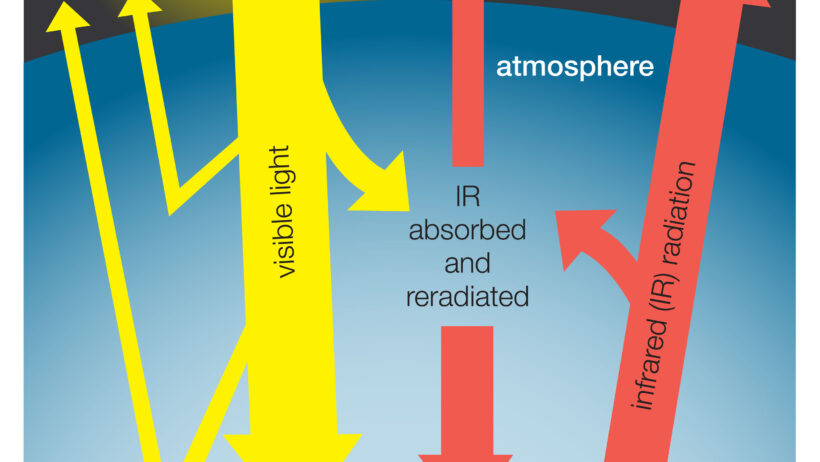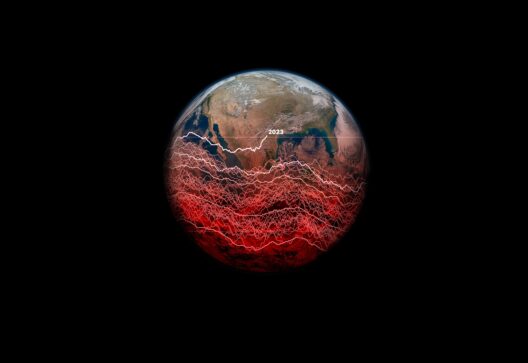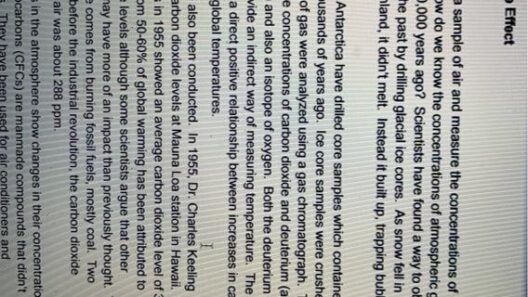The Earth’s climate system is an intricate web of interactions that determine the conditions suitable for life. At the core of these interactions lies the phenomenon known as the greenhouse effect. Understanding how greenhouse gases contribute to global warming is crucial for comprehending the challenges we face in this era of climate change. This article delves into the mechanisms of the greenhouse effect, the role of various gases, and the implications of rising global temperatures.
In its essence, the greenhouse effect is a natural process that warms the Earth’s surface. When the sun’s radiation reaches the Earth, some of it is reflected back to space and the rest is absorbed, heating the planet. Subsequently, the Earth emits this energy in the form of infrared radiation. Greenhouse gases in the atmosphere, such as carbon dioxide (CO2), methane (CH4), and nitrous oxide (N2O), trap some of this outgoing infrared radiation. This retention of heat keeps the planet warm enough to sustain life. However, human activities have significantly augmented the concentration of these gases, thereby intensifying the greenhouse effect and leading to global warming.
To better understand this phenomenon, it is essential to examine the role of various greenhouse gases in greater detail.
Greenhouse Gases: The Unsung Heroes and Villains
Carbon Dioxide (CO2): The Prolific Culprit
Carbon dioxide is the most significant anthropogenic greenhouse gas, primarily emitted through fossil fuel combustion, deforestation, and various industrial processes. Once released into the atmosphere, CO2 remains for an extended period, making it an enduring contributor to the greenhouse effect. Its absorption of infrared radiation causes a warming effect that has been scientifically linked to the upward trajectory of global temperatures.
Methane (CH4): The Powerful Gas
Methane, although present in the atmosphere in smaller quantities than carbon dioxide, is far more efficient at trapping heat. It has a global warming potential over 25 times greater than that of CO2 over a 100-year period. Methane emissions primarily arise from agricultural practices, landfills, and the production and transport of coal, oil, and natural gas. The increasing reliance on natural gas—a fossil fuel touted as a cleaner alternative—has also contributed to methane emissions. The role of methane in enhancing the greenhouse effect cannot be understated, as its potency amplifies the urgency of addressing this gas in climate action agendas.
Nitrous Oxide (N2O): The Overlooked Contributor
Nitrous oxide is another significant greenhouse gas, released mainly from agricultural and industrial activities, as well as during combustion of fossil fuels and solid waste. It is estimated to be over 300 times more effective than CO2 at trapping heat over a century. The agricultural sector, especially through the use of synthetic fertilizers, is a primary source of N2O, and thus, policies promoting sustainable farming practices are critical in mitigating its emissions.
Understanding the interconnectedness of these greenhouse gases is vital in recognizing their collective impact on global warming. As the levels of these gases continue to rise due to human activities, greater heat retention occurs, leading to accelerated climatic changes.
Mechanisms of Global Warming: How Greenhouse Gases Operate
At the heart of the greenhouse effect is the intricate balance between incoming solar radiation and outgoing infrared radiation. The Earth’s natural equilibrium has been disrupted, primarily due to anthropogenic emissions. Increased levels of greenhouse gases enhance the greenhouse effect, primarily in two significant ways:
Increasing Absorption of Infrared Radiation
As the concentration of greenhouse gases climbs, more infrared radiation is absorbed. This additional layer of heat contributes to a rise in global average temperatures. While this warming allows for a habitable climate, the excess heat leads to a multitude of environmental consequences.
Feedback Loops: A Self-Perpetuating Cycle
The warming caused by greenhouse gases sets off a series of feedback loops. For instance, as temperatures rise, polar ice melts, reducing the Earth’s albedo—a measure of reflectivity. With less sunlight reflected back into space, more heat is absorbed, further exacerbating warming. Similarly, thawing permafrost releases methane, which enhances the greenhouse effect even further. Such feedback mechanisms illustrate the precariousness of the climate system once certain thresholds are exceeded.
The Implications of Rising Temperatures: A World in Peril
The ramifications of global warming are profound and far-reaching. One of the most immediate effects is the increase in average temperatures, which can lead to catastrophic weather events, including more severe storms, prolonged droughts, and unpredictable rainfall patterns. The implications for agriculture are significant; crop yields may decline while food security becomes increasingly threatened. Furthermore, the rise in sea levels due to melting polar ice caps jeopardizes coastal communities worldwide.
In addition to physical impacts, the socio-economic consequences are daunting. Vulnerable populations, particularly in developing nations, face the brunt of these changes due to limited adaptive capacity. Displacement caused by extreme weather events, such as hurricanes and flooding, exacerbates poverty and migration challenges.
The Path Forward: Mitigation and Adaptation Strategies
Addressing the greenhouse effect and global warming requires urgent and collective action. Mitigation strategies should focus on reducing emissions from fossil fuels, enhancing energy efficiency, and transitioning to renewable energy sources. Implementing robust policy frameworks that aim to curb greenhouse gas emissions, promoting sustainable agricultural practices, and fostering energy conservation are essential steps towards a more sustainable future.
Furthermore, adaptation strategies must accompany mitigation efforts. Investing in resilient infrastructure, protecting natural ecosystems, and developing community-based approaches to climate adaptation are pivotal in ensuring societies can navigate the challenges posed by a warming planet.
In conclusion, understanding the mechanisms of the greenhouse effect and its contribution to global warming underscores the urgent need for concerted action. As global temperatures rise, the implications span across ecological, social, and economic realms. Everyone has a role to play—through individual choices and systemic changes—to combat this pressing issue and secure a sustainable future for generations to come.







